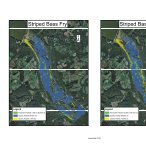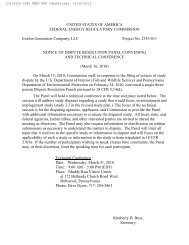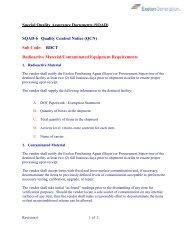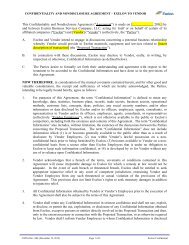Final Report Historical Structures Assessment Report for the Muddy ...
Final Report Historical Structures Assessment Report for the Muddy ...
Final Report Historical Structures Assessment Report for the Muddy ...
Create successful ePaper yourself
Turn your PDF publications into a flip-book with our unique Google optimized e-Paper software.
Historic <strong>Structures</strong> <strong>Assessment</strong> <strong>Report</strong> <strong>for</strong> <strong>the</strong> <strong>Muddy</strong> Run Pumped Storage Facility Project Relicensing Application<br />
Lancaster and York Counties, Pennsylvania<br />
Consideration B: A building or structure removed from its original location but which is significant<br />
primarily <strong>for</strong> architectural value, or which is <strong>the</strong> surviving structure most importantly associated with<br />
a historic person or event; or<br />
Consideration C: A birthplace or grave of a historical figure of outstanding importance if <strong>the</strong>re is no<br />
appropriate site or building directly associated with his or her productive life; or<br />
Consideration D: A cemetery which derives its primary significance from graves of persons of<br />
transcendent importance, from age, from distinctive design features, from association with historic<br />
events; or<br />
Consideration E: A reconstructed building when accurately executed in a suitable environment and<br />
presented in a dignified manner as part of a restoration master plan, and when no o<strong>the</strong>r building or<br />
structure with <strong>the</strong> same association has survived; or<br />
Consideration F: A property primarily commemorative in intent if design, age, tradition, or symbolic<br />
value has invested it with its own exceptional significance; or,<br />
Consideration G: A property achieving significance within <strong>the</strong> past 50 years if it is of exceptional<br />
importance.<br />
REGISTRATION REQUIREMENTS FOR PENNSYLVANIA: CRITERION A-<br />
AGRICULTURE<br />
As requested by PHMC, <strong>the</strong> Ritchie-Robinson Farm was re-evaluated utilizing <strong>the</strong> recently completed<br />
York-Adams County Diversified Field Crops, Cannery Crops, And Livestock, C. 1750-1960 Multiple<br />
Property Documentation Form (McMurry 2011). The NRHP eligibility with respect to agriculture in each<br />
Historic Agricultural Region of Pennsylvania will depend upon how well a given property reflects <strong>the</strong><br />
historical farming system in that region. According to <strong>the</strong> Historic Agricultural Resources of<br />
Pennsylvania, c. 1700-1960: a National Register Multiple Property Documentation Form, Criterion A<br />
significance should be assessed in relation to how a given property typifies a farming system, not in<br />
relation to whe<strong>the</strong>r a property is exceptional or unusual. A property should exemplify a farming system in<br />
all its aspects. The totality of a property’s representation in <strong>the</strong> areas of production, labor patterns, land<br />
tenure, mechanization, and cultural traditions will determine its National Register eligibility (McMurry<br />
2011: 119).<br />
A key characteristic of Pennsylvania agricultural production from settlement to about 1960 is<br />
diversification on small family farms. There<strong>for</strong>e, a farmstead, farm, or historic agricultural district should<br />
reflect diversified agriculture through a variety in historic buildings and landscape features. It is critical to<br />
note that diversified agricultural production involves two facets: 1) a mix of products and 2) a variety in<br />
use <strong>for</strong> those products. Historic resources should reflect <strong>the</strong> variety of household and market strategies<br />
employed by farming families (McMurry 2011: 119).<br />
In addition, according to <strong>the</strong> registration requirements <strong>for</strong> <strong>the</strong> York-Adams Historic Agricultural Region,<br />
to be determined significant with respect to Criterion A <strong>for</strong> agriculture, a farmstead should ei<strong>the</strong>r: 1)<br />
possess a strong representation of typical buildings and landscape features from one chronological phase<br />
of <strong>the</strong> region’s agricultural history, or 2) possess a strong representation of a range of typical buildings<br />
and landscape features that illustrate important changes over time in <strong>the</strong> region’s agricultural history. A<br />
historic agricultural district should have a more or less contiguous collection of farms representing <strong>the</strong>se<br />
features (McMurry 2011: 118). Whe<strong>the</strong>r it depicts one chronological period or change over time, a<br />
farmstead will normally be significant under Criterion A only if: 1) its individual production system, <strong>for</strong><br />
<strong>the</strong> period in question, reflects <strong>the</strong> average or above average production levels <strong>for</strong> its township in <strong>the</strong> same<br />
7
















